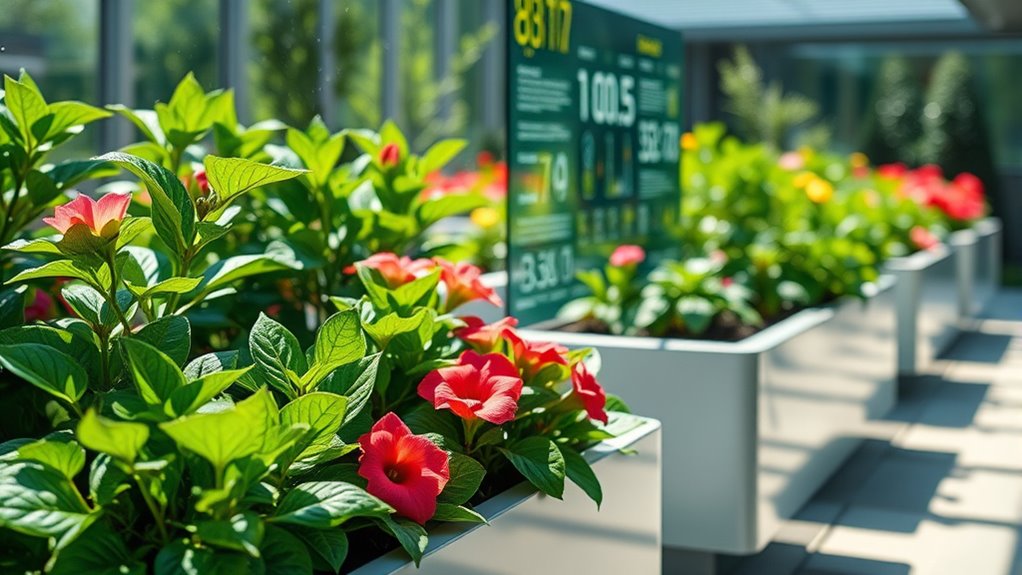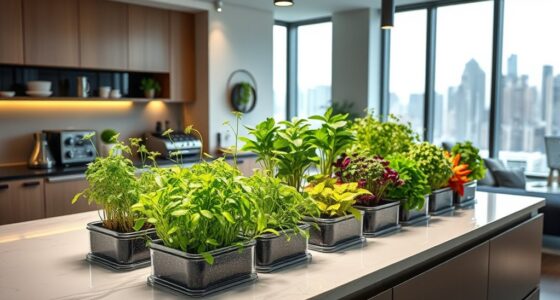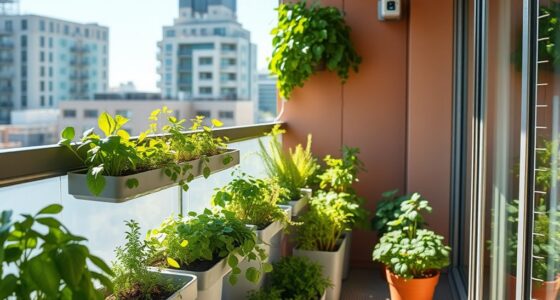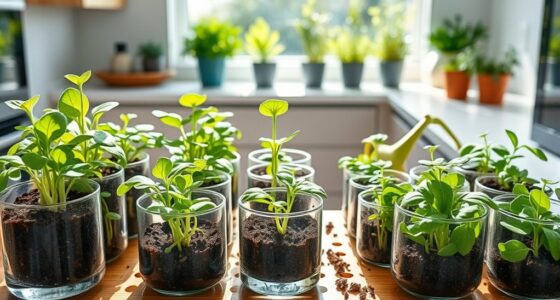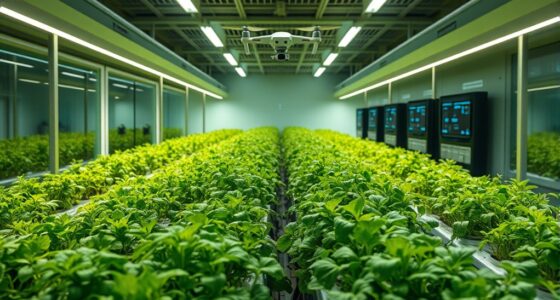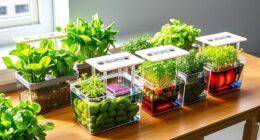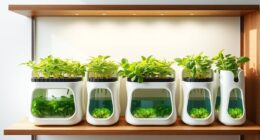Many believe smart gardens are completely maintenance-free and require no effort, but that’s not true. They help with watering and care but still need monitoring, adjustments, and regular upkeep. They’re easy for beginners but not set-and-forget solutions. Automated watering assists plant health but doesn’t guarantee perfect results. To truly understand their capabilities and limits, explore these common myths further—there’s more to discover that can help you succeed in your indoor gardening journey.
Key Takeaways
- Smart gardens require ongoing monitoring and maintenance; they are not entirely hassle-free solutions.
- They are designed for beginners and novices, not just experienced gardeners or tech enthusiasts.
- Automated watering helps but doesn’t guarantee perfect plant health without proper oversight.
- These systems are user-friendly but still need regular checks, refills, and troubleshooting.
- Smart gardens assist plant care but cannot replace essential gardening knowledge and manual intervention.
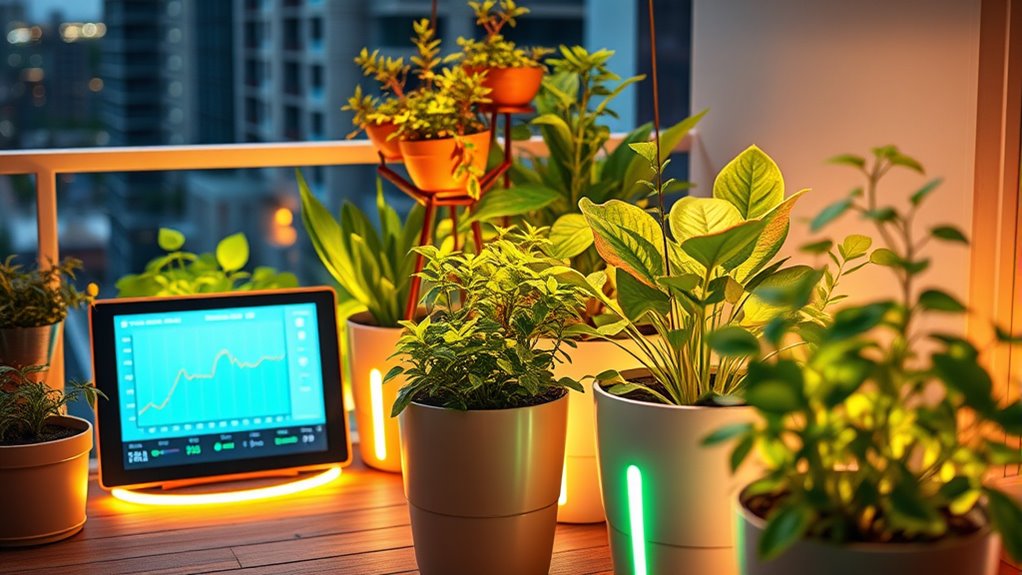
Are smart gardens truly the effortless solution they’re often made out to be? It’s a common belief that these devices make indoor gardening completely hassle-free. While smart gardens do simplify certain tasks, they’re not magic. When you invest in one, you might expect it to handle everything flawlessly, but that’s not entirely accurate. The reality is that, although these systems use automated watering to maintain your plants, they still require your attention and care. Automated watering helps help ensure your plants don’t dry out or drown, but it’s only part of the equation. You need to monitor moisture levels and adjust settings periodically, especially if you’re growing different types of plants with varying water needs. Smart gardens can reduce the time and effort needed for watering, but they don’t eliminate the need for regular maintenance or troubleshooting. Additionally, understanding the self watering system can help you better manage your indoor garden’s health and troubleshoot issues effectively.
Many people believe that indoor gardening with a smart garden is completely maintenance-free. That’s a misconception. While these systems are designed to be user-friendly, they aren’t set-and-forget solutions. You’ll still need to select suitable plants, ensure they have adequate light, and replace nutrients or refill water reservoirs as needed. Sometimes, automated watering systems malfunction or become clogged, requiring you to intervene and fix issues. Although the technology is advanced, it’s not immune to glitches. Expect to check on your smart garden periodically to confirm everything is working properly, especially in the early stages as you learn the system’s quirks.
Another myth is that smart gardens are only for seasoned gardeners or tech enthusiasts. In reality, they’re accessible to beginners and anyone interested in indoor gardening. These systems are designed to be intuitive, with apps or touchscreens guiding you through setup and maintenance. However, understanding how to optimize conditions for your specific plants is still essential. You’ll need to learn about light requirements, watering schedules, and occasional plant care practices to keep your indoor garden thriving. The automation makes the process easier but doesn’t replace the need for basic gardening knowledge.
Frequently Asked Questions
Can Smart Gardens Replace Traditional Gardening Entirely?
Smart gardens can’t fully replace traditional gardening, but they do complement urban gardening and DIY gardening efforts. With smart gardens, you get convenience and year-round growth, making them perfect for small spaces or beginners. However, they lack the same variety and hands-on experience of traditional gardening. So, while they’re great for supplementing your gardening journey, they shouldn’t be seen as a complete replacement for hands-on, traditional gardening methods.
Are Smart Gardens Suitable for All Climate Zones?
Smart gardens offer good climate adaptability, but their regional suitability varies. You should consider your local climate conditions, like temperature and humidity, to determine if a smart garden will thrive. In moderate zones, they usually perform well, but in extreme climates—either very hot, cold, or humid—you might need additional adjustments. Check the product specifications and consult local gardening experts to confirm your smart garden will suit your specific climate zone.
Do Smart Gardens Require Professional Maintenance?
You don’t need professional maintenance to enjoy a smart garden, as most are user-friendly and designed for easy care. With minimal effort, you can enhance urban aesthetics and support plant diversity right in your space. Regular watering, occasional pruning, and monitoring the app are usually enough. This way, you maintain a thriving garden that boosts your environment without the hassle of professional help, making it perfect for busy urban dwellers.
How Energy-Efficient Are Smart Garden Systems?
Smart garden systems are quite energy-efficient, helping you reduce overall energy consumption. They typically use LED grow lights and automated watering, which are designed to maximize eco-friendliness and minimize waste. By optimizing light and water use, these systems lower your environmental impact while providing fresh herbs and vegetables. You’ll find them a sustainable choice, aligning with eco-friendly living goals and making your gardening both efficient and environmentally conscious.
Can Smart Gardens Grow All Types of Plants?
It’s a coincidence that smart gardens can support such diverse plant life, but growth limitations do exist. While they excel at growing herbs and small vegetables, you might find some plants struggle due to space or light constraints. Plant diversity varies depending on the system’s features, so you should check whether your smart garden can accommodate the specific needs of the plants you want to grow.
Conclusion
Don’t let misconceptions hold you back from trying a smart garden. Many believe they’re complicated or expensive, but actually, 68% of users report increased plant success and reduced maintenance. Smart gardens are designed to make gardening easier and more accessible for everyone. So, go ahead—embrace the technology and enjoy fresh herbs or veggies at home. With facts like these, there’s no reason not to give smart gardening a try today!
